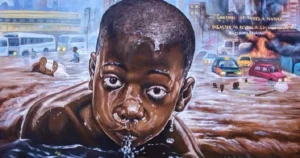Ghana Remembers: A Decade Since the Tragic June 3, 2015, Twin Disaster
Today, June 3, 2025, marks the 10th anniversary of one of Ghana’s deadliest modern tragedies: the devastating fire and flood disaster that claimed the lives of hundreds in Accra. On that fateful night in 2015, a combination of torrential rains, severe flooding, and a catastrophic explosion at a fuel station near Kwame Nkrumah Circle plunged the nation into mourning.
The Catastrophe Unfolds:
Torrential Rains and Flooding: Accra experienced several days of heavy rainfall leading up to June 3, 2015. On the evening of June 3, intense, prolonged downpours caused massive flooding across the capital, particularly in low-lying areas like Kwame Nkrumah Circle. Water levels rose rapidly, engulfing buildings, vehicles, and critical infrastructure. Many residents, caught in the downpour, sought shelter wherever they could find it, including the GOIL fuel station.
The GOIL Station Explosion: The situation turned catastrophic when a sudden explosion occurred at the GOIL filling station directly opposite Vienna City. Investigations later revealed that leaking fuel from the station’s tanks mixed with the floodwaters, creating a volatile, widespread layer of fuel on the surface.
The Fatal Spark: A government-appointed committee investigated the disaster and concluded that a lit cigarette, reportedly dropped by an individual named Seth Kwesi Ofosu, ignited the fuel-laced floodwaters. This sparked a massive inferno that swept through the flooded area, trapping and burning people caught in the neck-high waters and raging flames.
Grim Aftermath: The twin disaster resulted in a horrific loss of life. While initial reports varied, official figures settled on 154 fatalities, with another 154 people suffering injuries, many of them severe burns. The sheer volume of bodies overwhelmed the morgue at the 37 Military Hospital, Ghana’s largest specialist hospital. The fire also damaged five structures, including the filling station itself, causing an estimated GH¢1.65 million in property loss.
Impact and Response:
National Mourning: Then-President John Dramani Mahama declared three days of national mourning following the tragedy. He visited the disaster site, expressing profound grief and describing the loss as “catastrophic and unprecedented.”
Blame and Contributing Factors: President Mahama, among others, largely attributed the widespread flooding to human activities, including blockages in Accra’s main storm drains, non-desilting of drains, and unauthorized construction on waterways. The committee’s report specifically highlighted the flooding as the remote cause, fuel overflow as the intermediate cause, and the cigarette stub as the final spark.
Calls for Accountability and Prevention: In the immediate aftermath, and even now, on the 10th anniversary, civil society groups like the OneGhana Movement have called for accountability and justice for the victims. They demand compensation for affected persons and legal action against relevant institutions. They also urge the government to publish the committee’s full report and its white paper on the findings. Survivors continue to appeal for more support, noting the profound long-term difficulties they face.
Ongoing Challenges: While some remedial efforts have been undertaken over the years, including some dredging of the Odaw River, many still believe that deeper structural issues persist. Poor urban drainage, inadequate waste management, and unregulated construction continue to pose significant risks to Accra residents, underscoring the vital lessons Ghana must continue to learn from this devastating day.
The June 3, 2015, disaster serves as a poignant reminder of the critical importance of robust urban planning, effective waste management, and diligent disaster preparedness in preventing future tragedies.
Join our socials
https://www.instagram.com/stranacmedia/
https://x.com/stranacmedia
@stranacmedia

